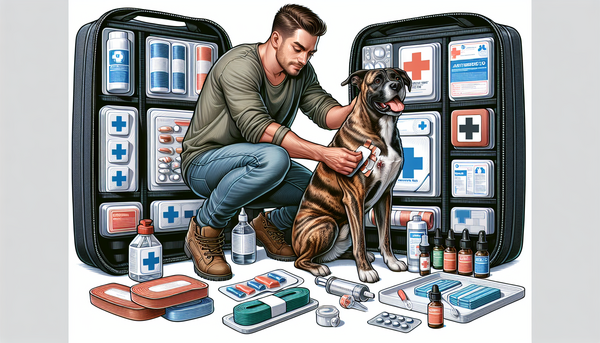Introduction to Canine First Aid
As a devoted dog owner, your furry friend’s well-being is a top priority. Being prepared for any mishap is part of the unspoken bond you share with your canine companion. That’s why understanding canine first aid is essential for every pet parent. In this comprehensive guide, we’ll cover all the vital knowledge you need to handle dog health emergencies and provide the best pet safety tips to ensure you’re ready for any situation that may arise.
Creating a Dog First Aid Kit
Before diving into the intricacies of canine first aid, every dog owner should have a well-stocked first aid kit tailored for their pet. Start by visiting your local pet store or check out reputable online retailers. Some items to include are adhesive tape, gauze pads, digital thermometers, and antiseptic wipes. Don’t forget the contact information of your veterinarian and the nearest emergency clinic!
Recognizing Common Dog Health Emergencies
Being able to quickly identify signs of distress or illness in your dog can be the difference between a minor incident and a serious emergency. Symptoms like sudden lethargy, uncontrolled bleeding, or difficulty breathing warrant immediate attention. Remember, your prompt response can save your dog’s life, so familiarize yourself with these crucial signs.
Reacting to Choking Incidents
Choking is a terrifying event for any pet owner. If your dog shows signs of choking, such as pawing at their mouth or making choking sounds, act quickly. Knowing the Heimlich maneuver for dogs is invaluable, and guides on performing it safely can be found through the American Red Cross’s Pet First Aid app or reputable sources like the AKC’s guidance on the Heimlich maneuver.
Handling Cuts and Wounds
Minor cuts and scrapes can often happen during playtime or adventures outdoors. For minor wounds, clean the area gently with water or an antiseptic wash and apply a pet-safe antibiotic ointment. However, for deeper wounds, immediate veterinary care is necessary. Learn more about wound care through sources like Veterinary Partner to ensure you’re always prepared.
Dealing with Broken Bones
If you suspect your dog may have a fracture, it’s crucial to immobilize the affected area and transport them to the vet as calmly and carefully as possible. Avoiding any unnecessary movement is vital to prevent further injury. Consult with professionals like those at ASPCA Animal Poison Control Center for advice on handling these situations until professional help is available.
CPR for Dogs: A Lifesaving Skill
Canine CPR could be a lifesaving procedure in an emergency. If your dog is not breathing and does not have a pulse, performing CPR immediately is imperative. For current guidelines on performing CPR on dogs, refer to the American Red Cross or training provided by organizations like the American Red Cross Pet First Aid.
Paw-sitive Prevention Strategies
Prevention is always better than cure, so it’s important to keep potential hazards like toxic plants, harmful foods, and small objects out of paw’s reach. Ensure a safe environment for your dog by following these simple pet safety tips and regularly checking your home for anything that could pose a risk to your pet’s health.
Regular Veterinarian Check-ups and Vaccinations
Regular check-ups with a veterinarian are essential for maintaining your dog’s overall health. Vaccinations, parasite control, and routine examinations help in preventing emergencies before they occur. Consistent veterinary care is the cornerstone of a long, healthy life for your furry friend.
Conclusion: Your Role in Your Dog’s Safety
- Take canine first aid classes offered by local organizations.
- Maintain an updated first aid kit and emergency contact list.
- Regularly review canine first aid techniques to keep your skill sharp.
- Stay calm during emergencies to ensure you can act effectively.
- Always seek professional veterinary assistance when needed.
Armed with these canine first aid basics, you’re now better equipped to handle any emergencies that come your way. Remember that while you can’t predict when an accident will happen, being prepared can make all the difference. For more tips and guidance, stay connected with us here on Barklyz, where your dog’s health and happiness is our passion.






